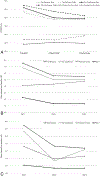Validation of Patient-Reported Outcomes Measurement Information System (PROMIS) computerized adaptive tests in cervical spine surgery
- PMID: 29303468
- PMCID: PMC7315645
- DOI: 10.3171/2017.7.SPINE17661
Validation of Patient-Reported Outcomes Measurement Information System (PROMIS) computerized adaptive tests in cervical spine surgery
Abstract
OBJECTIVE The Patient-Reported Outcomes Measurement Information System (PROMIS), which is funded by the National Institutes of Health, is a set of adaptive, responsive assessment tools that measures patient-reported health status. PROMIS measures have not been validated for surgical patients with cervical spine disorders. The objective of this project is to evaluate the validity (e.g., convergent validity, known-groups validity, responsiveness to change) of PROMIS computer adaptive tests (CATs) for pain behavior, pain interference, and physical function in patients undergoing cervical spine surgery. METHODS The legacy outcome measures Neck Disability Index (NDI) and SF-12 were used as comparisons with PROMIS measures. PROMIS CATs, NDI-10, and SF-12 measures were administered prospectively to 59 consecutive tertiary hospital patients who were treated surgically for degenerative cervical spine disorders. A subscore of NDI-5 was calculated from NDI-10 by eliminating the lifting, headaches, pain intensity, reading, and driving sections and multiplying the final score by 4. Assessments were administered preoperatively (baseline) and postoperatively at 6 weeks and 3 months. Patients presenting for revision surgery, tumor, infection, or trauma were excluded. Participants completed the measures in Assessment Center, an online data collection tool accessed by using a secure login and password on a tablet computer. Subgroup analysis was also performed based on a primary diagnosis of either cervical radiculopathy or cervical myelopathy. RESULTS Convergent validity for PROMIS CATs was supported with multiple statistically significant correlations with the existing legacy measures, NDI and SF-12, at baseline. Furthermore, PROMIS CATs demonstrated known-group validity and identified clinically significant improvements in all measures after surgical intervention. In the cervical radiculopathy and myelopathic cohorts, the PROMIS measures demonstrated similar responsiveness to the SF-12 and NDI scores in the patients who self-identified as having postoperative clinical improvement. PROMIS CATs required a mean total of 3.2 minutes for PROMIS pain behavior (mean ± SD 0.9 ± 0.5 minutes), pain interference (1.2 ± 1.9 minutes), and physical function (1.1 ± 1.4 minutes) and compared favorably with 3.4 minutes for NDI and 4.1 minutes for SF-12. CONCLUSIONS This study verifies that PROMIS CATs demonstrate convergent and known-groups validity and comparable responsiveness to change as existing legacy measures. The PROMIS measures required less time for completion than legacy measures. The validity and efficiency of the PROMIS measures in surgical patients with cervical spine disorders suggest an improvement over legacy measures and an opportunity for incorporation into clinical practice.
Keywords: CAT = computer adaptive test; MCID = minimally important clinical difference; MCS = mental component score; NDI = Neck Disability Index; ODI = Oswestry Disability Index; PB = pain behavior; PCS = physical component score; PF = physical function; PI = pain interference; PRO = patient-reported outcome; PROMIS; PROMIS = Patient-Reported Outcomes Measurement Information System; cervical spine; patient-reported outcomes.
Figures







References
-
- Auffinger B, Lam S, Shen J, Roitberg BZ: Measuring surgical outcomes in subaxial degenerative cervical spine disease patients: minimum clinically important difference as a tool for determining meaningful clinical improvement. Neurosurgery 74:206–214, 2014 - PubMed
-
- Beaton DE: Simple as possible? Or too simple? Possible limits to the universality of the one half standard deviation. Med Care 41:593–596, 2003 - PubMed
-
- Beckmann JT, Hung M, Bounsanga J, Wylie JD, Granger EK, Tashjian RZ: Psychometric evaluation of the PROMIS Physical Function Computerized Adaptive Test in comparison to the American Shoulder and Elbow Surgeons score and Simple Shoulder Test in patients with rotator cuff disease. J Shoulder Elbow Surg 24:1961–1967, 2015 - PubMed
MeSH terms
Grants and funding
LinkOut - more resources
Full Text Sources
Other Literature Sources
Medical
Research Materials
Miscellaneous

